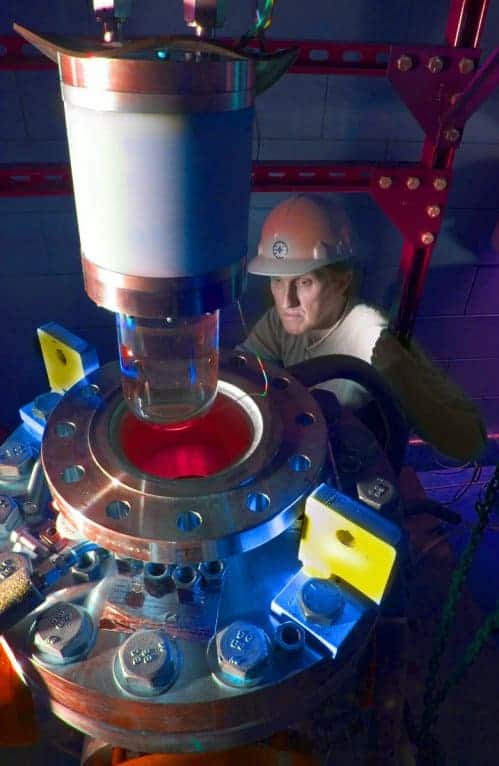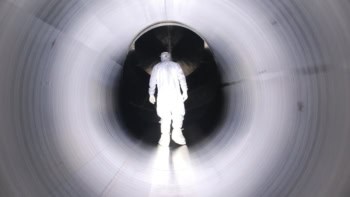
Bubble chambers, which were first used in the 1950s to detect electrically charged particles, might sound as if they should belong firmly to particle-physics history books. Now, however, physicists working at the Chicagoland Observatory for Underground Particle Physics (COUPP) experiment in the US have resurrected the technique to search for dark matter. Although their bubble-chamber experiments have failed to find any dark-matter particles, the null result has imposed new limits on certain properties of weakly interacting massive particles (WIMPs), which are a leading candidate for dark matter.
The COUPP team also says that their results casts further doubt on claims made in 1998 by members of the Dark Matter (DAMA) experiment at the Gran Sasso National Laboratory in Italy to have observed WIMPs. The DAMA team — which used a large array of sodium-iodide detectors located 1400 m below ground — insists that it is impossible to make a direct comparison between the two experiments.
Invisible to telescopes
Dark matter was first proposed about 70 years ago to explain the abnormally high rotation speeds of galaxies, which would otherwise be torn apart if they did not contain vast amount of hidden mass providing extra “gravitational glue”. It is fundamentally different from normal “luminous” matter such as stars as it is invisible to modern telescopes, giving off no light or heat, and seems to interact only through gravity.
Physicists believe that WIMPs might interact with ordinary matter through several different mechanisms that are either dependent or independent of the nuclear spin of atoms in ordinary matter. Although various experiments appear to have ruled out the possibility that the DAMA observations came from spin-independent interactions, they could still have been explained by a spin-dependent mechanism. Now that possibility appears to have been ruled out as well by the latest COUPP results.
Super-heated state
The COUPP experiment, which is located some 100 m underground in a tunnel at Fermilab, consists a glass jar filled with about a litre of CF3I — a liquid that is normally used as a fire-extinguisher (Science 319 933). The liquid is heated to just below its boiling point, at which point a piston is withdrawn ,which makes the chamber expand. This reduces the pressure of the fluid, leaving it in a super-heated state.
If a WIMP collides with a nucleus in the fluid, the recoiling nucleus heats the surrounding fluid, which boils and forms a tiny bubble. The bubble gets bigger as the chamber expands until it is large enough — about a millimetre in size — to be photographed by digital cameras.
COUPP watches for WIMP collisions nearly all of the time. By doing a statistical analysis of the bubbles in a large number photographs, the team says that they can work out which were caused by dark matter and which were caused by background radiation such as the alpha particles emitted during the radioactive decay of radon. Unlike old bubble chambers and most modern dark-matter search techniques, COUPP is insensitive to most other kinds of background radiation such as muons, gamma rays and X-rays.
If the DAMA result had been due to spin-dependent WIMPs, then COUPP researchers should have found hundreds of WIMPs. Instead, they found none above background. “These results establish the bubble chamber as a new competitive technique in the search for WIMPs as candidates for dark matter,” explains Fermilab’s Peter Cooper who is a senior scientist on COUUP. “They also contradict the observation claimed by DAMA in the last region not already excluded by other dark matter searches”, he said.
DAMA disagrees
However, Rita Bernabei at the University of Rome — spokesperson for the DAMA experiment — disagrees with that this conclusion. “It is impossible to make a direct comparison between the COUPP and DAMA results,” she told physicsworld.com. “In particular, COUPP uses different target materials and approaches [to DAMA]. She also pointed out that COUPP addresses also just one of several possible models of spin-dependent interaction, whereas the DAMA result was not tied to any specific interaction model — spin-dependent or otherwise.
COUPP is not the first experiment to put the DAMA results in question and several dark-matter searches since 1998 have failed to turn up any particles. However, Bernabei believes that like COUPP, these experiments use targets and approaches that are different to DAMA and therefore do not contradict their finding.
Spin-independent interactions
While COUPP does an impressive job of rejecting background radiation, it is relatively insensitive to spin-independent interactions, which are believed to be much more prevalent than spin-dependent scattering. As a result, some physicists have suggested that it is not a significant step towards the detection of WIMPs — unlike competing contemporary experiments such as XENON10 in Italy; CDMS in the US; and ZEPLIN-II in the UK.
Cooper and his COUPP colleagues are now working to increase the sensitivity by increasing the amount of liquid to 30 l in the bubble chamber, and hope to start testing the larger chamber at Fermilab soon.
“The path to much larger bubble chambers is clear and underway now,” says Cooper. “We plan to be operating up to 100 Kg of sensitive mass within a year. The ultimate limitations to this technique will be only the ability to control backgrounds.”




